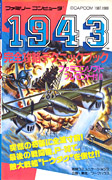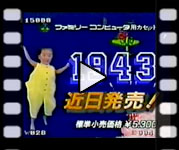|
1943 THE BATTLE OF VALHALLA
|
|

|

|
|
1943
©Capcom 1987,1988
Release: 1989-06-20 (¥5300)
Cartdridge CAP-43
Shooter/vertical


|
Released in America as
1943 THE BATTLE OF MIDWAY
( NES-43-USA )
|
|
1943 is a vertical shooter by Capcom and conversion of the arcade game
of the same name originally released in 1987 (and sequel of 1942). The game takes
place during World War II and is set in the Pacific air war theater. The
player takes control of a Lockheed P-38 Lightning American war plane and fights his
way through twenty four stages over the Midway Atoll, and the main goal of the game
is to annihilate the Japanese air fleet and sea forces. The P-38 comes
equipped with several forms of defense - a primary Vulcan Gun that can be charged up
by holding the fire button, and a special power attack that can be unleashed in a blinding
flash of lightning. However, the latter use some of the plane's own power - fuel is at the
core of the gameplay and it depletes as the game progresses, or when the player takes damage.
Power-ups are usually obtained by taking down formations of red planes, and they range from
Pow icons (restores energy), shotgun (upgrades the main weapon to a weak spread gun)
and double-cell (refills more energy). However, more weapons (such as a second
spread gun, lasers, missiles and so forth) can be unlocked as the game
progresses. Unlike its predecessor, 1943 gives the player the ability to customize the
P-38 before battle and throughout the game - offensive power, defensive power,
energy level, special weapons and special weapons time limit are all
attributes that can be modified and improved. Moreover, special power-ups are hidden throughout
the game, and although most of them give players extra energy or points, a special flower shaped
power-up icon gives players the opportunity to further improve the plane's stats
(a rare dragonfly icon also offers twice the number of power-up points). Finally
the game features a password system allowing players to save their progress.
|
 1943 Midway Kaisen (aka 1943 The Battle of Midway) was an arcade game originally released by Capcom in 1987.
This Famicom port greatly differs from the original arcade game. It consists of
twenty four stages instead of sixteen, and the level-up/customization screen is an
exclusive feature to this port (picture on the right). Although this power-up system gives players a lot more
flexibility, it changes the gameplay drastically. Unlike the original arcade game, some
of the most powerful weapons only appear later in the game as the player increases his
Special Weapon stats. The same applies to the maximum energy level which automatically
increases in the arcade game but has to be customized in this conversion. Finally, the
P-38 comes equipped with a power-shot, feature totally missing from the original
arcade game.
1943 Midway Kaisen (aka 1943 The Battle of Midway) was an arcade game originally released by Capcom in 1987.
This Famicom port greatly differs from the original arcade game. It consists of
twenty four stages instead of sixteen, and the level-up/customization screen is an
exclusive feature to this port (picture on the right). Although this power-up system gives players a lot more
flexibility, it changes the gameplay drastically. Unlike the original arcade game, some
of the most powerful weapons only appear later in the game as the player increases his
Special Weapon stats. The same applies to the maximum energy level which automatically
increases in the arcade game but has to be customized in this conversion. Finally, the
P-38 comes equipped with a power-shot, feature totally missing from the original
arcade game.
|
|
See 1942 (Fc) for more information about the 194x series.
|
Teaser text copied from the American version:
The most crucial and decisive
battle of World War II is about
to be fought... by you! Enemy
forces are descending upon Midway
Island. Enemy bombers, dive bombers,
and zeros are roaring over the island
like a typhoon. The surrounding Pacific
waters are teeming with enemy
aircraft carriers.
As the top gun of the Navy's most
elite crew of fighter pilots, you must
pilot your specially outfitted P-38 into
the very midst of the enemy squadron.
Equipped with an array of secret
weapons, only you can turn the tide
against the formidable enemy fleet.
The outcome of history's most fateful
air/sea battle rests on your hands! Can
you avenge Pearl Harbor?
|
G
O
O
D
I
E
S
|
|

Japanese Guidebook
|
|
|
O
M
A
K
E
|
|



|
|
|
Click on picture to enlarge |
|
|
|
LK

|
|
Add your Pov here !
|
P
O
V
s
|
|
Although 1942 for the Famicom/Nes system was twinged with
disappointment, this port of 1943 is magnificent and improves upon
its predecessor at just about every opportunity. Graphics are detailed and
sharp, enemies are reasonably varied and bosses are especially well designed.
The controls are very responsive, the plane moves and reacts with precision and
the music is solid and noteworthy (unlike the annoying 'beeping' sound that
plagued the prequel). Additionally, Capcom decided to add several extra
features exclusive to this port, such as the customization screen, the power shot,
the extra levels and the password system. Talking about the upgrade/customization
screen, I wish Capcom hadn't hidden the upgrade icons as they did. It took
me several plays to realize that I could get more upgrade points than the three
granted at the beginning of the game... Finally, backgrounds and levels are still
a bit repetitive (not as bad as 1942 though) and the game lacks variety in
terms of gameplay. But, all in all, 1943 is an excellent port that you
shouldn't miss if you're a fan of the 194x series.
|
|
|
|